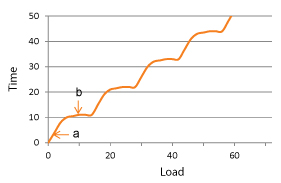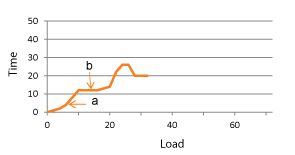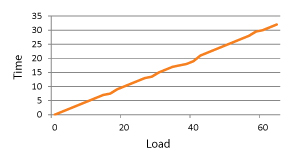
Pulling the Dolly Off the Coating
As well as applying the force perpendicularly to the substrate, the load fixed to the dolly should be applied in a steadily increasing manner over a specified time period. The relevant Standards may differ in the rate at which the load should be applied and the time period over which it should be applied, but they are all consistent in specifying a rate and time.
Typically, the stress should be increased by no more than 1MPa/s; however, the time over which the force should be applied varies from 90 to 240 seconds maximum, depending on the Standard. Whilst theoretically this is what is required, it is not so easy to achieve it in practice using manual devices. For example, when using the Elcometer 106, the force is applied by the turning of a hand wheel. Similar to when a jar is being opened, the initial force applied is the greatest and the force reduces as we complete the first twist.

In graph below, the region marked “a” is where the initial higher load is applied as the wrist reaches its turning limit. The load reduces significantly in zone “b”, the load therefore, cannot be said to have been applied particularly evenly.

When using a ratchet arrangement to apply the load, the force increases as the ratchet turns (zone “a”). Zone “b” indicates the area where the ratchet is “reset” to its original position, resulting in no applied load. Ideally the load should be applied at a constant rate; gauges such as the Elcometer 506, the Elcomerer 508 and the Elcometer 510 enable the user to do this.

Types of Failure
If the coating comes away completely, revealing the substrate or the previous coating, then this is an adhesive failure, as the coating has failed to adhere to the surface beneath it. If some of the coating comes away with the dolly and some of the same coating remains on the substrate or previous coating, then this is a cohesive failure as the coating has failed within the coating layer.

